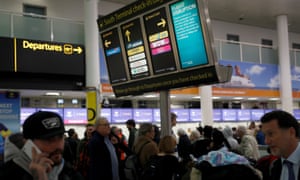I had hoped for a Christmas where the main stories about drones would be fun ones. You know, the ones where you’re allowed a little bit of schadenfreude as people have to climb a tree on Christmas Day to retrieve newly unpacked presents.
Alas, it has not been that kind of Christmas. Instead, the sighting of two or more drones, flown by an unknown number of people, with so far unknown motives, led to the closure of Gatwick, Europe’s eighth-largest airport, for 36 hours last week, followed by another, shorter closure a day later.
Sadly, airports being closed because of drones flying too close to the runways is not as rare as you might think. Dubai airport, Warsaw airport, Chongqing Jiangbei airport in China – all have had their operations disrupted in the last few years because of drones. By April last year, it had become such a regular occurrence in China that the drone manufacturer DJI offered £112,000 for information about anyone involved in the incidents.
And already in July 2017, Gatwick had to suspend all take-offs and landings for 14 minutes because of a drone, leading to the diversion of several flights. What’s more, the number of drone sightings that did not lead to the closure of airports is even higher.
A report by the Department for Transport last year counted 70 instances in 2016 where drones had been flown too close to commercial airliners and the numbers for 2017 and 2018 are likely to have reached triple digits.
The concern about drones flying near airports is understandable. Made out of plastic, metal and batteries, drones can present a real danger to an aircraft, in particular during take-off and landing. If no one has been hurt yet there have been suspected collisions in the past. Only last week, a Boeing 737 passenger jet, landing in Tijuana, Mexico, sustained damage to the nose when colliding with something that could have been a drone.
The events at Gatwick are, however, of a different order. No airport has ever been closed for so long. This shows two things. First, it points to intent, rather than neglect; the pilots of the drones clearly did not come too close to the runway by accident but deliberately disrupted the airport’s operation. Second, the fact that the Gatwick authorities did not succeed in downing the drones points to a central problem when confronting such small devices: to fight them, you have to be able to find them first.
This is a known problem: when in June 2016, a drone was spotted near Ottawa airport, the Canadian military sent up two CF-18 fighter jets to intercept it, but when they got to the site, they could no longer find the drone. The difficulty of detecting them has to do with their size (commercial and hobbyist systems usually have a radius of well under a metre), and with their speed, which is comparatively slow. Radars, which are in use at airports, are set up to detect bigger, faster aircraft.
The Ottawa incident also illustrates the difficulty of downing one. Sending up fighter jets is very much a “sledgehammer to crack a nut” situation, or even more fitting in this situation, as the German version of this saying goes, like “shooting sparrows with cannons”. This not only makes little economic sense, it is also problematic in a civilian context – as are many of the means the military uses to fight them.
Broadly speaking, there are three ways to down a drone – kinetically, electronically and by interception. The first translates to shooting down, with bullets, rockets or similar. The second – electronic solutions – is currently the most promising; here, the signal between the drone and its operator is jammed or interrupted. A more advanced version of this approach is to hack into the drone and take over the command.
Last, several ways have been concocted to intercept drones. For instance, further “saviour”drones have been manufactured that carry nets in which the offending drones’ rotors could be entangled. Even more creatively, the Dutch police and French military have been training eagles – yes, eagles –to intercept drones, albeit with limited success.
None of these solutions is perfect or works in every situation. Shooting into the air in any kind of environment where people are about is not a great idea and the same applies to jamming a wide range of frequencies. However, as civilian contexts go, an airfield devoid of people and from which no planes are taking off or landing appears as safe as environments get.
Which only adds to the questions that need to be asked of Gatwick. I would also like to find out whether the airport was furnished with any anti-drone technology. The United States Federal Aviation Administration, for instance, as early as 2015, was testing military-grade technology to keep commercial and personal drones from getting near airports.
One should not blame the Gatwick authorities for being overcautious, as the one thing worse than closing one of the UK’s busiest airports for a few days before Christmas would be to have an aircraft damaged or, God forbid, crash. Next year, let’s return to the tree stories.
Ulrike Franke is a drone specialist at the European Council for Foreign Relations, where she works on its New European Security Initiative
 Unmanned Aerial Vehicle The latest drone news
Unmanned Aerial Vehicle The latest drone news



